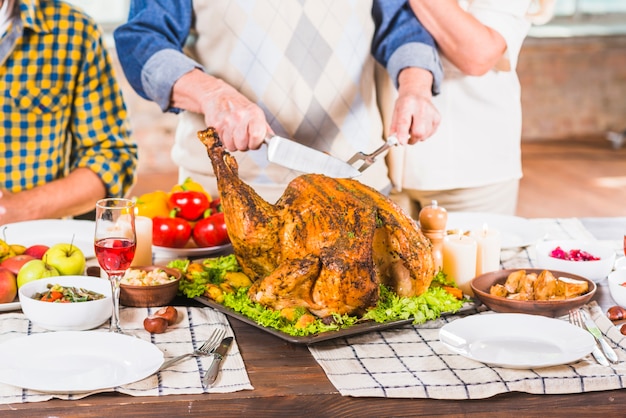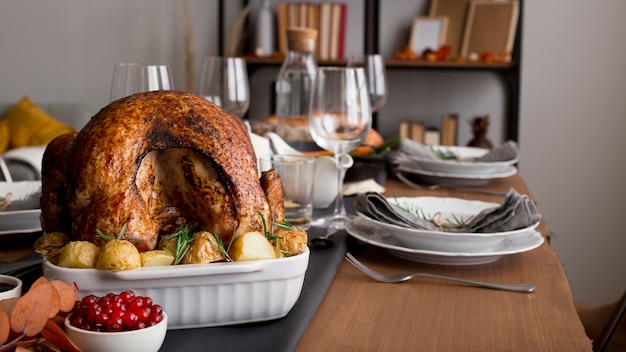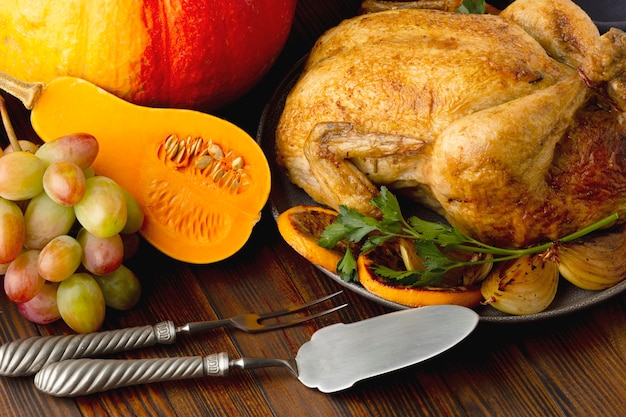Ah, the turkey. The majestic bird that reigns supreme on festive tables, its golden-brown skin glistening under the warm glow of the dining room lights. But let's face it, cooking a turkey can be a bit of a rollercoaster ride. One minute you're feeling confident, the next you're frantically searching for a meat thermometer, convinced your bird is going to be dry and tough as old boots. Fear not, my friends! I'm here to demystify the art of turkey cooking time, turning those jitters into joyous anticipation.
I've cooked my fair share of turkeys over the years, from triumphs that were the envy of the neighbourhood to culinary mishaps that I'd rather forget. But through it all, I've learned a thing or two about these magnificent creatures, their quirks, and how to coax out their best flavours. This guide is my love letter to all things turkey, packed with my personal tips, tricks, and a whole lot of turkey wisdom. Let's dive in, shall we?
(Part 1) Understanding the Basics: A Deep Dive

Before we get into the nitty-gritty of timing, let's tackle the fundamental factors that determine how long your turkey needs to cook. It's not as straightforward as you might think!
Size Matters: It's Not Just About Proportions
The size of your turkey is the most influential factor when it comes to cooking time. A smaller turkey will cook faster than a larger one, but it's not simply a matter of scaling the time proportionally. Think of it like this: a larger turkey has more mass, meaning it takes longer for heat to penetrate to the centre and cook it thoroughly.
For instance, a 10-pound turkey might take around 3 hours to cook, while a 20-pound turkey could take closer to 4.5 hours. That's why it's crucial to understand the relationship between size and cooking time, not just rely on a simple equation.
Cooking Method: From Oven to slow cooker, Each Has Its Own Pace
The way you choose to cook your turkey significantly impacts the cooking time. Roasting is the traditional, tried-and-true method, but you can also cook a turkey in a slow cooker, a pressure cooker, or even on the grill. Each method has its own personality, influencing the outcome and cooking time. For example, slow cooking brings out a tender, juicy turkey, but it also takes longer than roasting.
Oven Variations: Every Oven Has a Personality
Don't underestimate the role your oven plays in the turkey saga. Different ovens have varying heating capabilities, affecting how efficiently they transfer heat to your turkey. Some ovens run hotter, others run cooler, and some even have hot spots. This means your turkey might take a little longer or shorter depending on your oven's quirks. Always check the temperature with a meat thermometer, particularly in the last 30 minutes of cooking, to make sure your turkey is reaching the safe internal temperature.
(Part 2) Calculating Cooking Time: A Guide to Precision

Now that we understand the key players, let's get down to the nitty-gritty of calculating cooking time.
The Golden Rule: A Starting Point
For a stuffed turkey, allow about 15 minutes per pound of cooking time. For an unstuffed turkey, you can reduce that to 13 minutes per pound. This "golden rule" acts as a solid starting point, but remember, it's just a guide. Every turkey is unique, and you need to adapt your approach accordingly.
A Quick Example: Breaking Down the Calculation
Let's say you have a 12-pound unstuffed turkey. Using the golden rule, you'd calculate the cooking time as follows: 12 pounds x 13 minutes per pound = 156 minutes, or 2 hours and 36 minutes. However, this is just a rough estimate. Keep a close eye on your turkey, check the internal temperature, and be prepared to adjust the cooking time as needed.
(Part 3) turkey cooking time chart: A Handy Reference

To make life a bit easier, I've put together a handy chart that shows approximate cooking times for various turkey weights. Remember, these are just estimations, and it's always best to check the turkey's temperature using a meat thermometer to ensure it's cooked through.
| Turkey Weight (lbs) | Cooking Time (Unstuffed) | Cooking Time (Stuffed) |
|---|---|---|
| 10-12 lbs | 2 hours 30 minutes - 3 hours | 3 hours - 3 hours 30 minutes |
| 12-14 lbs | 3 hours - 3 hours 30 minutes | 3 hours 30 minutes - 4 hours |
| 14-16 lbs | 3 hours 30 minutes - 4 hours | 4 hours - 4 hours 30 minutes |
| 16-18 lbs | 4 hours - 4 hours 30 minutes | 4 hours 30 minutes - 5 hours |
| 18-20 lbs | 4 hours 30 minutes - 5 hours | 5 hours - 5 hours 30 minutes |
(Part 4) Don't Forget the Resting Time: A Crucial Step
After all that hard work, it's tempting to carve that beautiful turkey straight away. But resist! Allowing your turkey to rest for at least 30 minutes after cooking is a vital step that shouldn't be skipped. Think of it as a little reward for the turkey after its journey through the oven.
During this rest period, the juices redistribute throughout the turkey, ensuring it's deliciously moist and juicy when you carve it. The temptation to carve might be strong, but trust me, the wait is worth it. Your guests (and your taste buds) will thank you for it.
(Part 5) Temperature is King: Safe and Delicious
Now, let's talk about the crucial element of temperature. The best way to ensure your turkey is cooked through and safe to eat is to use a meat thermometer. No ifs, ands, or buts! It's the only way to be absolutely sure that your bird has reached the safe internal temperature.
Insert the thermometer into the thickest part of the thigh, making sure it doesn't touch any bone. The turkey is cooked when the internal temperature reaches 165°F (74°C). Don't rely solely on the pop-up timer in the turkey. These timers can be unreliable, and you don't want to take any chances with undercooked turkey.
(Part 6) Tips and Tricks: Elevating Your Turkey Game
Over the years, I've picked up a few tricks of the trade that have helped me elevate my turkey game. Here are some of my favourites:
Brining: A Secret for Juiciness
Brining is a great way to add moisture and flavour to your turkey. It's a bit of a commitment, but the results are well worth the effort. Simply soak the turkey in a salt-water solution for several hours (or overnight) before roasting. The salt draws out moisture and then redistributes it throughout the turkey, resulting in a juicier, more flavorful bird. You can also add herbs and spices to your brine for extra flavour.
Butterflying: Managing a Large Turkey
If you're dealing with a really large turkey, consider butterflying it. This involves splitting the turkey breastbone and flattening it out, which helps it cook more evenly and reduces the overall cooking time. It's a great technique for larger birds, ensuring that they cook through without the risk of dry breast meat.
Stuffing: A Delicious Addition with a Safety Note
If you're stuffing your turkey, make sure it's cooked to an internal temperature of 165°F (74°C). Stuffing can be a breeding ground for bacteria, so it's important to cook it thoroughly. You can also cook the stuffing separately to ensure it's safe to eat.
Glazing: The Final Touch
A glaze can add a beautiful sheen and extra flavour to your turkey. Start basting the turkey with a glaze (such as honey, maple syrup, or fruit juice) in the last 30 minutes of cooking. This will create a gorgeous, caramelized crust that adds both visual appeal and flavour.
Rest, Relax, Repeat: Patience Pays Off
Once your turkey is cooked, let it rest for at least 30 minutes before carving. This allows the juices to redistribute and ensures a moister, more flavorful bird. It's a little bit of patience that pays off big time!
(Part 7) FAQs: Addressing Common Questions
1. What's the difference between a fresh and frozen turkey?
A fresh turkey has never been frozen, while a frozen turkey has been frozen and then thawed. The cooking time for a fresh turkey is slightly shorter than for a frozen turkey. Always check the packaging for specific cooking instructions.
2. Can I cook a turkey in a slow cooker?
Absolutely! Slow cooking is a great way to cook a turkey, especially if you're looking for a more hands-off method. Just make sure you use a large enough slow cooker to accommodate your turkey. Slow cooking will result in a tender and juicy turkey, but it will take longer than other methods.
3. How can I tell if my turkey is done?
The best way to tell if your turkey is done is to use a meat thermometer. Insert the thermometer into the thickest part of the thigh, making sure it doesn't touch any bone. The turkey is cooked when the internal temperature reaches 165°F (74°C).
4. What if my turkey isn't cooked through?
If your turkey isn't cooked through, it's best to return it to the oven and continue cooking until it reaches the desired internal temperature. Never take any risks with undercooked poultry.
5. What should I do with leftover turkey?
Leftover turkey is a delicious and versatile ingredient. You can use it in sandwiches, salads, soups, and even in casseroles. It's also great for freezing for later use. Don't let those leftovers go to waste!
(Part 8) Conclusion: A Triumphant Feast
Cooking a turkey can be daunting, but with a bit of planning and the right information, it can be a truly rewarding experience. Remember to calculate cooking time based on the turkey's weight and your preferred cooking method, and always check the internal temperature with a meat thermometer.
Happy cooking! May your turkey be a culinary triumph, leaving your guests singing its praises!
Everyone is watching

How to Cook Frozen Lobster Tails Perfectly: A Step-by-Step Guide
RecipesLobster. Just the word conjures up images of lavish meals, special occasions, and a taste of luxury. But let's...

Pigs in a Blanket Cooking Time: How Long to Bake for Perfect Results
RecipesAh, pigs in a blanket. Just the name conjures up images of those delightful little parcels of crispy pastry en...

Pork Fillet Cooking Time: How Long to Cook It Perfectly
RecipesPork fillet, or tenderloin as it's sometimes called, is a real favourite in our house. It's so versatile, and...

The Ultimate Guide to Cooking Delicious Frankfurters
RecipesLet's face it, we all love a good frankfurter. It's a classic, simple, and always satisfying. But let's be rea...

Wolf Meat Recipes: A Guide to Cooking Wild Game
RecipesLet's be honest, you don't see wolf meat at your local butcher shop every day. It's a bit of a wild card, but ...
